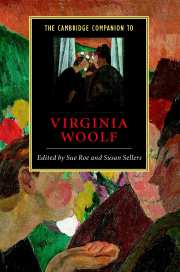Book contents
- Frontmatter
- 1 Bloomsbury
- 2 Finding a voice
- 3 Literary realism in Mrs Dalloway, To the Lighthouse, Orlando and The Waves
- 4 The novels of the 1930s and the impact of history
- 5 Virginia Woolf's essays
- 6 Virginia Woolf's diaries and letters
- 7 Virginia Woolf and the language of authorship
- 8 Virginia Woolf and modernism
- 9 The impact of post-impressionism
- 10 The socio-political vision of the novels
- 11 Woolf's feminism and feminism's Woolf
- 12 Virginia Woolf and psychoanalysis
- Guide to further reading
- Index
8 - Virginia Woolf and modernism
Published online by Cambridge University Press: 28 May 2006
- Frontmatter
- 1 Bloomsbury
- 2 Finding a voice
- 3 Literary realism in Mrs Dalloway, To the Lighthouse, Orlando and The Waves
- 4 The novels of the 1930s and the impact of history
- 5 Virginia Woolf's essays
- 6 Virginia Woolf's diaries and letters
- 7 Virginia Woolf and the language of authorship
- 8 Virginia Woolf and modernism
- 9 The impact of post-impressionism
- 10 The socio-political vision of the novels
- 11 Woolf's feminism and feminism's Woolf
- 12 Virginia Woolf and psychoanalysis
- Guide to further reading
- Index
Summary
Away and away the aeroplane shot, till it was nothing but a bright spark; an aspiration; a concentration; a symbol (so it seemed to Mr. Bentley, vigorously rolling his strip of turf at Greenwich) of man's soul; of his determination, thought Mr. Bentley, sweeping round the cedar tree, to get outside his body, beyond his house, by means of thought, Einstein, speculation, mathematics, the Mendelian theory. . .
(Mrs D, p. 30)The aeroplane scene in Mrs Dalloway combines many of the perspectives relevant to Virginia Woolf's modernism: intellectual, technological, social, and literary. As 'Einstein' suggests, modernist literature responded to radical intellectual developments in philosophy and science. In 1911, as Leonard Woolf recalled, 'Freud and Rutherford and Einstein' had begun 'to revolutionise our knowledge of our own minds and of the universe'. The late nineteenth-century philosophical work of Friedrich Nietzsche and Henri Bergson was equally significant. As the aeroplane suggests, modernism was also a response to technological innovation, particularly in the urban environment. As the setting in Greenwich suggests, it explored the nature of time. The distinction between psychological time and clock time, the durée and temps of Bergson's philosophy, underlies the modernist experiments with time and narrative form. Psychology and anthropology encouraged explorations of prehistorical time, and of primitive and mythic ideas of time. The aeroplane's evanescent sky-writing raises other issues: of reading and interpretation; of the transitory nature of modernist beauty; and, in the way that the spectacle unites a disparate group of characters, the nature of the crowd in the urban environment.
- Type
- Chapter
- Information
- The Cambridge Companion to Virginia Woolf , pp. 146 - 163Publisher: Cambridge University PressPrint publication year: 2000
- 6
- Cited by



